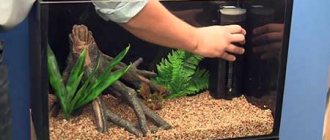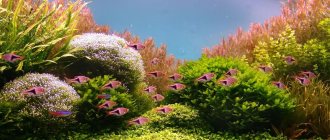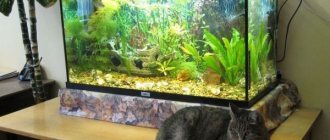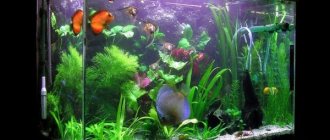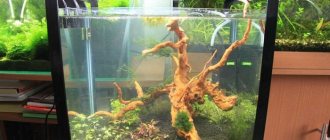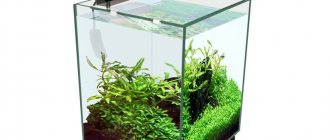Home › Aquarium equipment ›
( 1 ratings, average: 4.00 out of 5)
Aquariums of 30 - 40 liters are the most common home aquariums. What is the reason for such popularity?
Maybe you are a beginner and just decided to try yourself in a new hobby? Or are you not yet sure that you will not give up this idea? Then this is the right choice.
30 liters or 40 is a small volume of water. Not every novice aquarist will decide to purchase a large aquarium right away. A large capacity takes up a lot of space, and this is very important if you have a small apartment.
Equipment also takes up a lot of space - external filters, CO2 generator. In addition, a large aquarium means a larger volume of water that you will have to work with and make regular changes.
On the other hand, an aquarium with a volume of 30 to 40 liters is already a fairly large container. In such an aquarium you can plant more plants, add more fish and shrimp, have more space for decoration, and the environment in it will be more stable than in a 10-20 liter tank, which means there is a greater chance of a long-term existence of a mini aqua system.
An aquarium of 30-35-40 liters is a fairly small budget expenditure, but it is a full-fledged, albeit small, living world with a diverse population. This is a good choice for a beginner aquarist.
Types of aquariums
Aquariums from 30 liters most often have a length of 45 cm, a width of 25 cm and a height of 25 cm.
Shapes can be different: cubic, rectangular, with convex walls.
Material: glass, acrylic, highly transparent glass. It is better to give preference to glass - it is a more durable material, it does not scratch when cleaning algae from the walls. Also, glass remains transparent for a long time, while acrylic can turn yellow from sunlight. Acrylic, however, is a lighter material; in some cases it should be preferred.
Often such aquariums are sold together with equipment - lighting and filter.
The cost of equipment is usually low, which allows beginners to try a new hobby without spending too much money.
Beginners should understand that controlling balance and maintaining cleanliness and stability is much easier in larger aquariums. You have to take care of a 30-40 liter aquarium more often than larger ones.
Let's consider several options from best manufacturers.
Aquael SHRIMP SET SMART 30 liters
This aquarium is from the SET SMART line of Aquael aquariums, designed for breeding shrimp and small fish.
Size
29 x 29 x 35 cm.
Equipment
The kit includes an aquarium tank, a cover glass, a protective lining for the tank, an LED lamp, an inner filter, a heater, and shrimp food.
Description
A beautiful cubic aquarium. You can keep it not only shrimp, but also small fish, including betta. The composition includes almost everything you need, you just need to buy some soil.
Tetra AquaArt Aquarium Complete Set Discover Line 30 liters
Size
39 x 27.5 x 42.2 cm
Equipment
- Durable, distortion-free float glass container.
- Innovative Tetra EasyCrystal filter.
- Cover with 8 W T8 fluorescent lamp.
Description
This is an option from Tetra for keeping tropical aquarium fish. There are also other 30 liter options: Tetra AquaArt LED Aquarium 30L Goldfish for keeping goldfish with an LED lamp, Tetra AquaArt LED Explorer Line 30L White Edition - a white aquarium for keeping crayfish and crustaceans with a curved front wall.
Aquariums Nature
Dimensions
Capacities 32, 34, 40 liters.
Equipment
A rectangular glass container with a flat or oval front glass.
Cover with fluorescent lamps.
Description
High-quality inexpensive aquariums from a Kharkov manufacturer.
How to care for an aquarium
All pets require attention and care from their owner, and fish are no exception. Caring for the aquarium after launch is not difficult, once a week is enough:
- do a 30% water change;
- wash the equipment and the internal filter sponge;
- clean the soil and wash the walls.
fanfishka.ru
It is better to wash the equipment in water drained from the aquarium. It is undesirable to use running water, as this can kill the microflora and cause a new bacterial outbreak.
Equipment
As can be seen from the types of aquariums presented, many of them are sold in a set with the necessary equipment. However, the kit does not always have everything you need, and it is often more profitable to take only a water container and buy the missing equipment yourself. And, by the way, you can buy higher quality equipment separately. Let's consider what we generally need to equip the aquarium.
Filter
Perhaps the filter is the most important addition to the aquarium. An aquarium filter helps keep the water clean and healthy, which is especially important in small tanks such as 30-40 liters where nitrates accumulate faster and the water volume is smaller.
There are several different types of filters. If you are going to keep a small number of fish, then it is enough to purchase an internal filter. If you plan to use all the biological space, that is, populate the aquarium with fish and other animals to the maximum, then choose a filter with good biological filtration - canopy or external.
However, the choice of filter also depends on everything that will be in the aquarium: living plants, types of fish, type of soil.
If a large number of plants and small tropical fish or shrimp are expected, then it is enough to choose any internal or other filter; biological filtration is not so important.
If you want to keep goldfish or other types of “dirty” fish, you need to choose a more powerful filter that passes at least 5 volumes of aquarium water per hour.
If there are no plants, then you should give preference to filters with predominantly biological filtration.
Various manufacturers offer filters of different power, you need to choose according to the size of the aquarium and the population. The filter should pass 3-5 volumes of aquarium water per hour.
The cost of filters varies, on average from 20-30 dollars and more. But if you want to choose more expensive equipment, then know that investing in a filter is always justified.
Lighting
What kind of lighting is needed in an aquarium also largely depends on its contents. Therefore, you need to decide before purchasing which plants, fish and other animals will live there.
Some plants require strong light, otherwise they will stop growing, wither, get sick and eventually die. Even if the lamp is included, you may have to buy additional lamps, or replace the standard ones with brighter ones. You can find out more about the requirements for maintaining aquarium plants in the catalog.
Some fish also require brighter lighting, while others prefer darker conditions, and this must be taken into account both when choosing lighting and when choosing plants.
If you are a beginner and are buying a complete aquarium, then first choose aquarium plants for beginners - they grow in medium and even low light.
Heater
Heaters are very rarely included in an aquarium starter kit, as they are needed primarily for keeping tropical aquarium fish and shrimp, as well as for marine installations. If your chosen tropical fish require heating, you will have to buy a heater yourself.
There are not as many heaters on sale as filters, and they work the same way - just install the equipment in the aquarium and set the desired temperature. Choose a heater only with a thermostat. The heaters always indicate the displacement of the appropriate volume of water.
The heater is always installed closer to the water flow from the filter.
A thermometer is not included in the kit, but you must purchase one yourself in order to control the water temperature. A thermometer is placed on the opposite side of the heater to ensure that the entire tank is maintained at the desired temperature.
Priming
The next important point that beginners pay little attention to is aquarium soil. However, it is an important aquarium equipment for several reasons.
Calculate the amount of soil for the aquarium
The choice of soil is determined by what and who will live in the aquarium.
If there are living plants, you need to choose the soil that is suitable for the plants first of all. There is now a good selection of soils on sale for growing healthy, beautiful aquarium plants.
For some tropical fish species, it is recommended to choose a substrate of darker colors - it not only imitates their natural habitat, but also helps to emphasize the beauty and brilliance of underwater inhabitants.
Aquarium plants are incompatible with goldfish - these pets love to dig up gravel and move decorations from place to place. But there should still be gravel at the bottom; it helps create a natural atmosphere. It is better to choose fine soil or sand.
Large cichlids are not suitable for keeping in aquariums up to 40 liters, but some small African cichlids are quite suitable. But for some of them there are special requirements for water parameters, namely alkaline PH. This can be achieved using special gravel for cichlids.
In any case, there must be soil in an aquarium with any aquarium fish (unless it is a spawning tank or a container for raising fry). Thanks to the substrate, the aquarium looks more natural, which reduces stress levels in fish and shrimp. The soil itself is a good aquarium filter.
Optional equipment
- Substrate. An aquarium with water, soil and other equipment is quite heavy, so it is better to take care of the surface on which it will be installed in advance.
- Compressor. Some fish require increased oxygen levels in the water, such as goldfish and some species of corydoras. Using a compressor, you can provide more oxygen to the water.
- CO2 generator . This equipment is only necessary if there are living plants, and even then not all species need it.
- Scenery. And again, everything depends on the future inhabitants of the aquarium. Most Amazon tropical fish will thrive among driftwood and living plants, as will most catfish, which prefer natural cover. Some species of cichlids, such as the aggressive mbuna, prefer the likes of rocky slopes, that is, caves made of stones. Both living plants and decorations are contraindicated for digging fish. And shrimp definitely need living plants, preferably mosses and any other shelters. If the future inhabitants of your aquarium do not have any special preferences, you can decorate it as you wish.
- A clean bucket, siphon, and net are necessary equipment for caring for an aquarium.
- Air conditioning, water tests for ammonia, nitrites, nitrates.
Decorative elements
One of the most enjoyable moments in decorating a home pond for beginning aquarists is the choice of decorations. Decorations will give the tank a unique style and brightness, the main thing is that they do not overshadow the fish and other inhabitants of the aquarium.
The decorative elements are:
- Stones - they are bought in specialized stores or collected in nature. The main thing is that they do not contain limestone and do not have sharp edges that could injure the fish. Before immersion, the pebbles are thoroughly washed or boiled. The most popular stones for artificial ponds are quartz, flint and granite.
- Shells are sold in greater quantities and in a variety of colors, and are suitable for decorating an aquarium like no other. It is important to remember that sinks increase hardness, so when placing them you need to constantly monitor the water parameters.
- Driftwood will also be a great addition to the design.
In addition to the natural components of the underwater world, castles, chests with pirate gold, and models of sunken ships and boats will look beautiful in the pond. It is important not to overload the water space with an abundance of decorations, otherwise small fish, for example, guppies, will simply get lost against their background.
Live aquarium plants
An aquarium of 30 liters or 40 liters is already quite a spacious container, so the choice of plants expands significantly. You just need to avoid large species.
Excluded
- aponogetones;
- large species of Echinodorus;
- large cryptocorynes;
- too large, fast-growing, long-stemmed aquarium plants.
Can be planted
- All types of aquatic mosses.
- All ferns except large ones (bolbitis gedeloti).
- Rosette plants: small and medium-sized Cryptocorynes, Echinodorus, Nymphoides, Vallisneria, Blyxa, Pogostemon helfera, Eriokauron sinerium and other small plants.
- All types of ground cover: Marsilia, Micrantemum Monte Carlo, Lilaeopsis, Hydrocotyla tripartira, Staurogyne, Hemianthus cube and many others.
- Long-stemmed. Many aquarium plants are suitable for keeping, especially in a 40-liter aquarium, but avoid large and fast-growing species - they can take up all the available space in a short time (especially in good lighting). And floating on the surface they will shade the entire space below.
- Anubias.
- Bucephalandra.
Selecting invertebrates for a saltwater aquarium:
- Snails Lithopoma (Astraea) spp.
- Trochus
- Turbo
- Lysmata amboinensis
- Dardanus spp.
- Diadema antillarum
- Family Sabellidae
- Class Ophiuridea (brittle stars)
- Bivalves Tridacna crocea
- Tradacna maxima
Shrimps, hermit crabs, brittle stars, and snails are essential inhabitants of a full-fledged marine aquarium biotope. Hermit crabs can grow to large sizes and become a nuisance in the aquarium. Therefore, the free shells for them should not be large in size so that they do not grow quickly. Sea urchins should only be purchased for aquariums of sufficient size.
Aquarium fish, shrimp, snails
Thirty to forty liters is already a sufficient volume to accommodate a small flock of tropical aquarium fish up to 5 cm in length. But you should not overpopulate the container - in such a small space, the appearance of a large amount of nitrates, or even more so nitrites or ammonia, can lead to illness and even death of the population.
Excluded
- All large fish species (more than 10 cm) should be excluded. Or a 40-liter aquarium can be used “for growth,” so to speak, if you plan to purchase a larger container in the future.
You can start
| Name | Quantity |
| Guppy | 5-7 fish |
| Barbus cherry | 4-6 |
| Barbus Sumatran | 3-4 |
| Schubert Barbus | 4-6 |
| Cardinal | 7-9 |
| Rasbora cuneiformis | 4-5 |
| Rasbora espei | 7-9 |
| Pearl gourami | 2 |
| Gourami kissing | 2 |
| Danio rerio | 4-5 |
| Blue neon | 5-7 |
| Tetra Amanda | 10-13 |
| Corydoras panda, pygmy, habrobus, speckled | 3-5 |
| sword bearer | 2 |
| Minors | 5-7 |
| Microrasbora galaxy, erythromicron | 10-15 |
| Carnegiella | 6-9 |
| Tetradons dwarf | 5 |
| Pecilia | 4-8 |
| Apistogramma dwarf | 5-7 |
And other small fish. You can have from 4 to 10 of them, depending on the size of the adult. To find out for sure it is better to use a calculator to calculate.
- Cockerels. Even in a large volume, one individual can be housed, but the cockerel can be kept with other active and not very bright fish that are not similar to male cockerels.
- Ancistrus, Acanthophthalmus couleus - it is better not to purchase more than one individual and reduce the number of fish of other species.
- Goldfish. In a 40 liter aquarium you can only keep one adult goldfish, and even then it’s a stretch - these are quite large fish that need a lot of oxygen, so one individual requires 50 liters of water or 75 for a couple. For a group, a forty-liter aquarium can be used, but only for a while.
- Angelfish. Often, sellers assure buyers that a 40-liter aquarium is enough to keep them. However, the fish grow up and... die. This is because just one adult angelfish needs at least 40 liters of water. So again - only “for growth”.
- Large catfish - see above about angelfish and goldfish.
- African cichlids. Some species may be suitable even for keeping in such a relatively small volume of water (melanochromis maingano, auratus, yellow), but no more than two individuals.
- Neocaridine shrimp. In an aquarium of thirty or forty liters, shrimp can be kept either alone or with fish, you just need to provide these creatures with plenty of cover, and they will thrive. Aggressive species and biters are definitely excluded - cockerels, minors, barbs, mbuna cichlids.
Selecting the population
The biggest mistake a novice aquarist makes is overcrowding. If there are too many fish in the tank, the likelihood of poisoning with nitrogen compounds will increase to the limit and only a full restart will help correct the situation.
reefcoral.ru
What kind of fish can be placed in an aquarium:
- Gold fish. All kinds of varieties with similar colors attract beginner aquarists, but we do not recommend them. Only 1 individual can be placed in this volume and you will have to seriously care for it. Goldfish are very dirty in water, so powerful filtration will be required, and changes of 30% of the volume will have to be carried out at least once a week.
- Barbs. Schooling fish that look great in species aquariums and tirelessly delight their owner with their bustle. A flock of no more than 6 individuals can be placed in a container of this volume.
- Gourami. Completely unpretentious and relatively large fish. They have different colors, they can be marbled, honey, pearl and golden. “Snowflakes” are much less common. In 30 liters you can keep 2-3 individuals.
- Cockerels. Completely unpretentious fish, famous for their cocky disposition. It is almost impossible to keep a couple of males in one aquarium, so it is recommended to keep only one in a tank. Experienced aquarists subsequently manage to add females to it.
- Guppies, mollies and swordtails. Viviparous fish are a favorite among inexperienced aquarists. In a small container it is permissible to contain up to 6 individuals. But keep in mind that females will regularly produce viable offspring.
- Corridors. These are small bottom-dwelling catfish, ready to tirelessly sort through the soil and clean it of food residues after feeding. A container of this volume can contain no more than 2 individuals.
What to do if you want to house different fish? Let's consider options for a 30 liter aquarium:
- A couple of Corydoras and a flock of 6 Neons.
- One male guppy and a pair of females, a heterosexual pair of swordtails and mollies, corydoras.
- A couple of gouramis and a couple of corydoras.
- A couple of gouramis and no more than three guppies, mollies or swordtails.
In a container with a volume of 30 liters you can keep not only fish. You can add snails, frogs or shrimp. But keep in mind that starting an aquarium for such individuals has its own nuances.
ad-cd.net
Find out which fish help simplify aquarium care, and which are considered the most unpretentious and are recommended for beginners.
Aquarium installation
- A new aquarium can be washed with tap water to remove dust and dirt.
- Place the container on a sturdy, level surface, first placing a protective pad over it.
- The soil must be pre-rinsed (unless otherwise indicated in the instructions for use). Pour it into a clean bucket, fill it with tap water and stir. The procedure is repeated several times until the water is sufficiently clear.
- The soil is poured into the aquarium and placed along its bottom as desired. Decorations, driftwood, stones, etc. are placed.
- Fill with water that has been pre-treated with conditioner to remove chlorine. You will need about 3-4 buckets of water.
- Install a filter, heater, thermometer.
- Live plants can be planted when the aquarium is filled with water.
Preparing the aquarium and equipment for it
s.sakh.com
We recommend that you pay attention to water tanks of classic shape (rectangular or square). Caring for such containers is somewhat easier than round ones. In addition, it can be difficult to accommodate all the necessary equipment in the latter.
When the aquarium is at home, you can start preparing the water. Tap liquid contains many substances that are dangerous to the aquarium inhabitants, so it must be defended. For an aquarium of 30 liters, this is not difficult to do; it is enough to prepare 3 plastic bottles of 10 liters each. You need to soak the water for at least 12 hours, during which time all harmful impurities will be removed.
If the volume of the aquarium is larger and it is problematic to settle the water, you can fill it with regular water, but you will have to spend extra money on an air conditioner that neutralizes chlorine.
For the normal flow of the nitrogen cycle, the aquarium must have soil. If you plan to plant living plants, it is better to choose quartz or proppant. This substrate should be thoroughly washed beforehand to remove dirt, and kept in a separate container for 24 hours. If there is a lot of dust and it is not possible to rinse the composition, you need to boil it. We strongly recommend choosing soil of natural shades. Colored mixtures release toxic compounds into the water and poison the lives of fish.
We put soil on the bottom, fill it with water and be patient - we just have to wait a little and after a week, if the balance is stable, it will be possible to launch fish. But, already at this stage it is worth thinking about design. It’s difficult to turn around in 30 liters, but it’s possible. It is permissible to use driftwood and stones, shells, if the idea allows.
Starting an aquarium
Immediately after installation, the aquarium is not ready to receive the population. The fact is that bacteria must first settle in it, processing fish waste products: breaking down ammonia into nitrites, and them into less dangerous nitrates. This process is called the nitrogen cycle, and starting an aquarium means allowing the nitrogen cycle to establish itself. The nitrogen cycle can take from 2 to 8 weeks to establish.
There are different options for starting an aquarium. There is an opinion that the container only needs to be left alone for this period, and the cycle will start. However, for the necessary bacteria to appear, they first need food - ammonia, and if there are no fish, then there is no food. Therefore, bacteria may not appear for a long time, especially in the required quantity. What to do?
Option 1: Add ammonia yourself at 2-4 ppm every few days. Then the water is tested using tests for the presence of harmful substances (ammonia, nitrites, nitrates). In a neglected aquarium, only nitrates can be in the water; there should be no other decomposition products, as well as ammonia itself. This is not the best option because it is difficult to determine the right amount of ammonia.
Option 2. Add preparations containing bacteria to start the aquarium. In this case, the bacteria again need food, and ammonia must be added. And there is an opinion that such drugs are a product of commercial PR and are little effective, if at all useful.
Option 3. Gradual biological filling. I believe that this is the safest and most effective way to start an aquarium. In this case, it is recommended to introduce fish (or shrimp) gradually, not all at once. In the first week, 1/3 of the maximum population - so the ammonia that appears in the water will be the least toxic to fish. After a week, the water is tested. If ammonia is not detected, the aquarium population is replenished.
Thus, the nitrogen cycle is established quickly enough and is least dangerous for the population.
Vegetation placement
Plants are not only a decoration for the aquarium, but also an integral part of the microflora of the underwater world. They allow you to saturate the water with oxygen and also serve as shelter for many species of fish.
For beginners, it is better to choose unpretentious plant species. In a relatively small house, not exceeding 30 liters, you can “settle” the following types of greenery:
- Heteranthera;
- Congo fern;
- Javanese, Key or Weeping moss;
- Pogostemon Helfera;
- Hornwort;
- Anubias Barthera dwarf;
- Hemianthus dwarf Cuban.
The amount of greenery is planted in accordance with the volume of the aquarium; the plants should not be too dense. Otherwise, guppies, catfish or barbs will feel uncomfortable.
Introducing fish into the aquarium
- Check the temperature of the water in the aquarium to see if it is warm enough to start the fish. The thermometer should be installed as far as possible from the heater.
- Turn off the light and lower the bag of fish onto the surface of the water for 15 minutes.
- Open the bag of fish and add half a glass of aquarium water every 15 minutes for an hour.
- During this time, the fish will get used to your water parameters. Remove the fish from the bag with a net and release it into the aquarium. There is no need to pour the water from the bag into the aquarium - it may contain pollutants or pathogens.
- Leave the lights off for a few hours to allow the fish to get used to their new surroundings.
Content
For cleaning you need:
- net for catching fish;
- siphon for soil cleaning;
- glass scraper.
Weekly maintenance of the aquarium takes place in 4 stages:
- soil siphon;
- quarter water change;
- equipment washing;
- cleaning glass from plaque.
Get a second aquarium for quarantine, fish spawning and a nursery for the young. Another spacious container will do. After purchasing a fish, do not immediately place your new neighbor in a common aquarium. Keep your new pet in a quarantine container for several weeks. If the fish does not show signs of illness, you can add it to the others. Neglecting quarantine puts the lives of the inhabitants of the reservoir at risk, because most diseases are introduced with new fish. Sick fish are also kept in a quarantine tank where they undergo treatment.
If fish breeding occurs, then a couple of breeders are deposited. Some fish show aggression towards others during spawning. The additional capacity will allow the fry to grow separately from their parents and not be eaten.
Plants for aquarium 30 liters
Plants are needed for natural filtration and to create shade for secretive fish. Greens are involved in many biological processes taking place in a body of water, for example, absorbing carbon dioxide or harmful inorganic compounds. Beautiful and unpretentious plants:
- Elodea;
- Cryptocoryne;
- Java moss;
- Hornwort;
- Heteranthera doubtful;
- Yakut.

